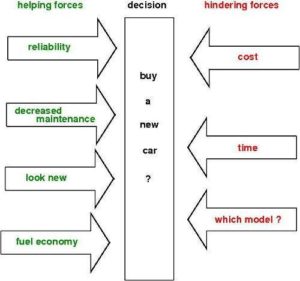
Mastering Force Field Analysis

Force field analysis is a technique used to analyze and evaluate the forces that support or resist a proposed change It identifies the driving forces for change and the restraining forces that oppose it, allowing for a more informed decision-making process
The balance between forces seeking change and those maintaining the status quo is crucial to understanding issues, according to Kurt Lewin's theory. While commonly associated with modern psychology, theories such as Maslow's Hierarchy of Needs and Lewin's Force Field Analysis can also be applied to business. As the founding father of modern psychology, Lewin's work on force fields and diagrams has proven to be particularly relevant.
An example of Force field analysis.
One force is the driving force, which is the force that motivates and pushes towards the change. The other force is the restraining force, which is the force that opposes and resists the change. By identifying and evaluating both forces, we can determine the potential success or failure of implementing the change and develop strategies to overcome any obstacles. Force Field Analysis is a powerful tool for businesses to use in decision-making and change management processes.
1. Driving force
2. Restraining force
Identifying the driving and restraining forces is crucial in determining the sustainability of change in an organization. If a customer demands a new product, it can act as a driving force for the company, while an inability to handle new technology can act as a restraining force. Conducting a Force Field Analysis can help in identifying the strength of these forces and making effective decisions for change. Furthermore, this analysis can aid in explaining decisions and developing strategies to manage the driving and restraining forces.
During the Force Field Analysis, it is important to consider various factors that may impact the proposed change. These can include resource availability, organizational structure, regulatory requirements, relationships, institutional policies and norms, and other relevant forces. While the process of conducting the analysis may seem straightforward, it can require significant effort and planning. To begin, it is necessary to identify the specific problems that require change and define the desired outcomes or changes that are required. With this information in hand, a structured approach can be taken to analyze the relevant forces at play and develop strategies to overcome barriers to change.
To mitigate subjectivity, create a two-column diagram and work with relevant employees to identify driving and restraining forces. Next, score each force on a scale of 1 (weakest) to 5 (strongest), based on its strength and degree of influence. Finally, calculate the total score for each column to determine the feasibility of the change.














